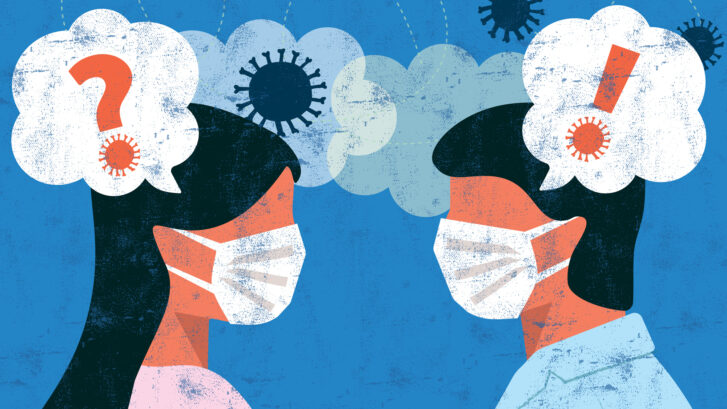New Guidance on COVID-19 Can Be Confusing
Sometimes it seems as though we need a spreadsheet to keep track of all the changing information and recommendations on COVID-19.
- Masks/no masks?
- Boosters? Maybe not, maybe now, maybe later.
- Quarantine? Yes, no, who, and how long?
Our primary care concierge doctors in Jupiter don’t mean to criticize the researchers and public officials who are responsible for keeping us healthy. The SARS-CoV-2 coronavirus is, after all, a disease we’d never seen until early in 2019. No one knew how to deal with it.
And thanks to the combined efforts of scientists around the world, we’ve made tremendous strides in the effort to combat it.
But one thing few counted on was “pandemic fatigue,” which meant many people rapidly grew tired of taking precautions and radically altering their lifestyles to help stem the spread of COVID-19.
Which may be what’s behind the latest guidance from the Centers for Disease Control and Prevention (CDC). (https://www.cdc.gov/media/releases/2022/p0811-covid-guidance.html)
A new approach
This month the CDC relaxed many of its coronavirus recommendations, leaving measures to battle to limit viral spread largely up to individuals.
According to The Washington Post:
- “No longer do schools and other institutions need to screen apparently healthy students and employees as a matter of course.
- “The agency is putting less emphasis on social distancing—and the new guidance has dropped the ‘six-foot’ standard.
- “The agency’s focus now is on highly vulnerable populations and how to protect them—not on the vast majority of people who at this point have some immunity against the virus and are unlikely to become severely ill.”
In releasing the new guidance, the CDC cited improved tools like vaccination, boosters, and treatments to better protect ourselves from the virus.
“We also have a better understanding of how to protect people from being exposed to the virus, like wearing high-quality masks, testing, and improved ventilation,” Greta Massetti, a CDC epidemiologist, said in a statement.
“This guidance acknowledges that the pandemic is not over, but also helps us move to a point where COVID-19 no longer severely disrupts our daily lives,” she added.
Isolation changes
In one fairly substantial shift, for example, the CDC no longer recommends quarantine if you’re up to date with your vaccines and have been exposed to COVID-19. Instead, you should mask for 10 days and get tested on Day Five.
Additional CDC guidance on isolation includes the following:
- If you’ve tested positive and have a healthy immune system, regardless of your vaccination status, you should isolate yourself for five days. On Day Six, you can end isolation if you no longer have symptoms or have not had a fever for 24 hours and your symptoms have improved.
- Once isolation has ended, you should wear a high-quality mask through Day 10. If you test negative on two rapid antigen tests, however, you can stop wearing your mask sooner.
- Until Day 11 at least, you should avoid visiting or being around anyone who is more likely to have severe outcomes from COVID-19, including the elderly and people with weakened immune systems.
These changes stem from a new statistic, according to Massetti: 95 percent of the U.S. population has at least some level of immunity against the virus, either from vaccination or previous infection.
What about boosters?
As for booster shots, the U.S. Food and Drug Administration (FDA) finally decided last month against allowing adults younger than 50 to become eligible for a second booster vaccine (for a total of four mRNA shots).
Currently, only those age 50 and older and children at least 12 years old with impaired immune systems can get a second booster.
This is because the agency expects to have reformulated mRNA boosters available by next month that will contain components from both the original virus and its variants, as well as from the currently circulating (and highly contagious) omicron subvariants BA.4 and BA.5.
Meanwhile, the FDA still recommends that anyone under age 50 receive a single booster shot, and people older than 50 or those with weakened immune systems receive a second mRNA booster.
The mask question
No one likes wearing masks, especially in the heat. However, our primary care concierge doctors believe it’s better to err on the side of caution, especially if you’re immunocompromised or older than 65.
Especially given the new CDC guidance revisions, there’s no harm in wearing a mask in crowded indoor situations with poor ventilation.
It’s true that we now have effective treatments for COVID-19, but given the risk of long COVID—one recent study found that as many as one in every eight people who contracted it had lingering symptoms—what’s the point in taking unnecessary chances?
It’s up to you, of course, but in a recent interview with The Post, Ziyad Al-Aly, an epidemiologist at Washington University in St. Louis, compared the current state of the country to “the Wild West.”
“There are no public health measures at all,” he told the paper.
“We’re in a very peculiar spot, where the risk is vivid and it’s out there, but we’ve let our guard down and we’ve chosen, deliberately, to expose ourselves and make ourselves vulnerable.”

